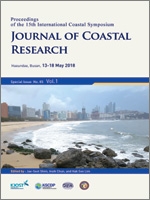Costa, M.S.; Rocha, A.S.; Santos, A.S., and Rolnic, M., 2018. Influence of tide on salt entrapment in the River Mojuim Estuary. In: Shim, J.-S.; Chun, I., and Lim, H.S. (eds.), Proceedings from the International Coastal Symposium (ICS) 2018 (Busan, Republic of Korea). Journal of Coastal Research, Special Issue No. 85, pp. 81–86. Coconut Creek (Florida), ISSN 0749-0208.
The aim of this study is to check whether there is salt entrapment in an estuary in the Amazon eastern coast. This study case was conducted in a section of the lower Mojuim River estuary. Tide, current, and water salinity were measured for 25 h during wet and dry seasons, 2014. Tide and salinity levels were recorded at fixed stations for 55 consecutive days during each season. Advective, diffusive, and dispersive salt transport and the Stratification/Circulation diagram were calculated. The Mojuim River estuary has a macrotidal, semidiurnal regime, with tide height of 4.9 m during spring tide and 3.2 m during neap tide. Maximum current intensities during wet season are 1.6 m.s−1 in flood tide and 1.9 m.s−1 in ebb tide, whereas during dry season, they are 1.2 m.s−1 in ebb tide and 1.6 m.s−1 in flood tide. Mean salinity increased from 7.3 g.kg−1 (±2.82) during wet season to 21.2 g.kg−1 (±3.62) during dry season. Advective salt transport was 736.4 kg.s−1 during wet season and 72.1 kg.s−1 during dry season, up-estuary and down-estuary, respectively. River discharge and Stokes transport are the predominant components of advective salt transport. It allows salt entrapment in the estuary during extreme tides, which might be retained in the floodplains. As the Mojuim river estuary is shallow (mean depth 4.5 m), the water column varies according to the fluvial component and to tides. Thus, the intensity of the fluvial component and tides during wet season promotes eddy mixture. During dry season, a decreased fluvial component due to low rainfall increases saline intrusion and causes the water column to be slightly stratified. The Mojuim river estuary was classified as well mixed during wet season and slightly mixed during dry season, according to the Stratification/Circulation diagram.





